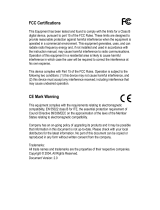
3
Table of Contents
1.
Overview ........................................................................................................................ 5
1.1. Introduction ................................................................................................................. 5
1.2. Package Contents ...................................................................................................... 5
1.3. Hardware Illustration .................................................................................................. 6
2. Installation ..................................................................................................................... 7
2.1. Install Hard Disk ......................................................................................................... 7
2.2. Hard Disk Recommendation List ................................................................................ 9
2.3. Setting Up ................................................................................................................. 10
2.3.1. Office/ Home ...................................................................................................... 10
2.3.2. Individual ............................................................................................................ 10
2.4. LED / System Status ................................................................................................ 12
2.5. Configure Software Settings ..................................................................................... 14
2.5.1. Windows® Users ............................................................................................... 14
2.5.2. Mac Users .......................................................................................................... 20
3. Powerful Services ....................................................................................................... 27
3.1. Server Administration ............................................................................................... 31
3.2. Quick Configuration ..................................................................................... 32
3.3. System Settings .......................................................................................... 36
3.3.1. Server Name ...................................................................................................... 36
3.3.2. Date & Time ....................................................................................................... 37
3.3.3. Encoding Setting ................................................................................................ 38
3.3.4. View System Settings ........................................................................................ 38
3.4. Network Settings ......................................................................................... 39
3.4.1. TCP/ IP Configuration ........................................................................................ 39
3.4.2. Microsoft Networking ......................................................................................... 41
3.4.3. Apple Network .................................................................................................... 42
3.4.4. Web File Manager .............................................................................................. 42
3.4.5. FTP Service ....................................................................................................... 43
3.4.6. Multimedia Station ............................................................................................. 44
3.4.7. Download Station ............................................................................................... 45
3.4.8. Web Server ........................................................................................................ 45
3.4.9. View Network Settings ....................................................................................... 46
3.5. Device Configuration ................................................................................... 47
3.5.1. SATA Disk .......................................................................................................... 48
3.5.2. USB Disk ............................................................................................................ 50




















